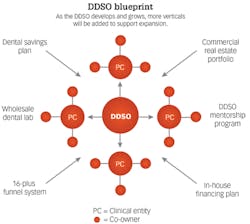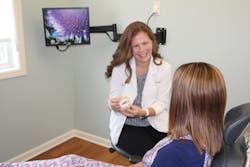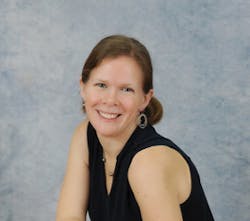DDSO blueprint series, Part 3: Personalizing your ideal lifestyle in dentistry
By Emily Stopper, DDS
Introduction by Brady Frank, DDS
There’s been a lot of discussion regarding the financial advantages of the various dentist-owned dental support organization (DDSO) models now available to the private practitioner. Along with these financial advantages, I am a firm believer that the lifestyle benefits of DDSO models deserve to be talked about too.
Back in the day, there was talk about “female practice ownership” not being conducive to a thriving family life. But things have changed. Today, as dentists leverage their business lives through multidoctor ownership models, ownership is entirely compatible with family and recreational life. Female dentist-owner entrepreneurs are now crushing it in business and living life on their terms. Emily Stopper, DDS, is one such individual who is an owner in a ten-operatory, three-doctor location DDSO (figure 1). Her story is an inspiration to me.
Discussion by Emily Stopper, DDS
Achieving work-life balance is not easy. If you have children, I believe it is even more challenging. No one wants to miss out on important events in their children’s lives. I believe most of us go into dentistry desiring to help people and also to have a lifestyle in which we can pursue our passions. At the same time, being a practice owner often consumes a significant amount of our energy. I think that is why some dentists choose the associateship route—so they can forego practice ownership and all it entails. However, I’m here to tell you that you can be a practice owner and still have a life.
I am a mom to three small children, each under five years old. While on maternity leave with my youngest son, I did not look forward to returning to work. In fact, I dreaded it terribly. As the time drew closer, I cried nearly every day just thinking about going to work and leaving my children behind. I felt like my job as a dentist owned me. I even looked into trading stock options as a second career.
I then began to listen to dental podcasts. I would binge-listen to Dentalpreneur, a podcast hosted by Mark Costes, DDS. When I listened to Dr. Costes interview Brady Frank, DDS, about partnerships and multipractice ownership, I immediately knew that I needed to talk to Dr. Frank to find out how I could practice dentistry on my own terms.
Figure 1: This schematic is an overview of the various vertical components of Dr. Stopper’s DDSO. As the practice grows, the verticals continue to add more value to each owner dentist. Owners enjoy more opportunity to pursue additional business ventures through a well-constructed and well-planned DDSO.
As I went down this new path, my mindset about practicing dentistry and practice ownership completely changed. I realized that there was much more to attain from ownership than I was experiencing. For the first time, I felt energized about what ownership—and ultimately multipractice ownership—could mean for me and my life. I learned about mentorship, collaboration, and shared responsibility of a multidoctor practice. It was thrilling.
I made the decision that I was going to take control of my life and finally choose how I wanted to practice. Instead of my job owning me, I was going to take control of my practice and be a true business owner. I realized that with multiple doctors sharing the patient load, I could practice on my own terms and pursue what I was most passionate about. For me, that was treating obstructive sleep apnea.
My journey to become a provider of sleep apnea treatment began when my mother-in-law flew in from Kansas to stay with us for a week. She didn’t bring her CPAP. She told me how much she hated wearing it and that she usually wore it for only two hours each night. She didn’t want to travel with it. I didn’t think too much of it at the time. I didn’t know much about sleep apnea anyway. But over the course of her visit, I heard her stop breathing throughout the night. I would hear loud snoring sounds and then nothing at all for what seemed like minutes. All of a sudden she would wake up choking and gasping for air. It terrified me! I was afraid she was going to die during her visit.
I was somewhat aware of dental treatment for sleep apnea, but after hearing my mother-in-law struggle to breathe, I knew I had to do something. I scheduled myself for the first sleep apnea course I could find—and I never looked back. I am so glad I did. Treating sleep apnea has given me some of the most rewarding professional experiences of my life.
Through treating sleep apnea, I truly have a hand in helping save lives. I love hearing patients tell me how much better they feel. I routinely receive thanks and hugs for helping them and their spouses get a better night’s sleep. It is definitely better than hearing, “No offense, Doc, but I hate the dentist.” Not only that, I have freedom with my time. I get to be with my family. I get life on my terms. I only see my ideal patients, and I have a profitable business that doesn’t require me to be there more than two days per week.
Now that I have achieved my personal goals in the business of dentistry, my mission is to help new dentists get started on the right foot with practice ownership—especially women who are new dentists and want to have an incredible life outside of dentistry.
I have found that there are four primary components required for successful investment in value-added mentorship practices (a type of DDSO model) without having to practice in those locations. Those components are as follows:
- A new dentist with a desire for practice ownership
- A value-added practice to acquire
- A funding source
- An educational and support platform
When the four pillars are in place, it is then time to acquire the practice so that all parties may reap the benefits of practice equity increase and profitability.
The most successful platform to operate these is through a DDSO mentorship program. In this case, the new dentist and the mentor dentist go into the deal 50-50. The new dentist has a dental license and the desire to maximize his or her career in dentistry. The mentor brings the success of his or her existing practice to the table, vendor discounts, in-person clinical mentorship, a financial safety net, marketing momentum, social media presence, and a top-notch team to provide practice management support. Both parties receive the benefits of equity increase and greater profitability through the shared mentorship relationship. They have a shared goal of shaving 5–10 years off of the new dentist’s learning curve and accelerating the new dentist’s ownership stake and income level. This offers similar stability and security to that of an associateship—but with all the benefits and tax advantages of ownership.
I wish these programs were available when I graduated from dental school! When practice owners choose to mentor new dentists and invest in the profession, dentistry has a very bright future.
Author’s note:Text “Book” to 31996 for further information on Dr. Frank’s DDSO book. Additional resources may be found at: ddsoblueprint.com, ddsomastery.com, ddsofunnels.com, and theddsoalliance.com.
Brady Frank, DDS, is an international clinical and business lecturer, an inventor, and a founder of multiple companies in the dental space. Since graduating from the Marquette University School of Dentistry in 2001, he has owned multiple private dentist-owned groups (DDSOs). He is a founding member of the DDSO Alliance. Reach him at
[email protected].
Editor’s note:This article is part three of a five-part series. Part four will appear in September. Find previous articles at dentaleconomics.com. Search “DDSO blueprint.”
About the Author

Brady Frank, DDS
Brady Frank, DDS, is a third-generation dentist turned entrepreneur, inventor, author, and thought-leader with a passion for teaching others the hard-won lessons he has learned about successfully creating and selling a business. Dr. Frank has expertise on multi-doctor and multi-location private group practices, dental transitions, DSO and DDSO expansion and growth strategies, and healthcare real estate investment, and is most passionate about mentoring others on these topics.



